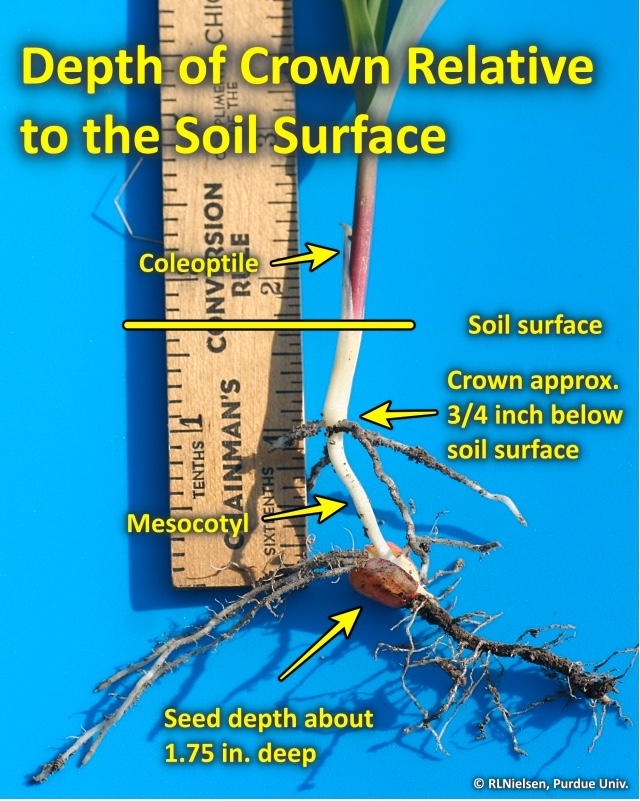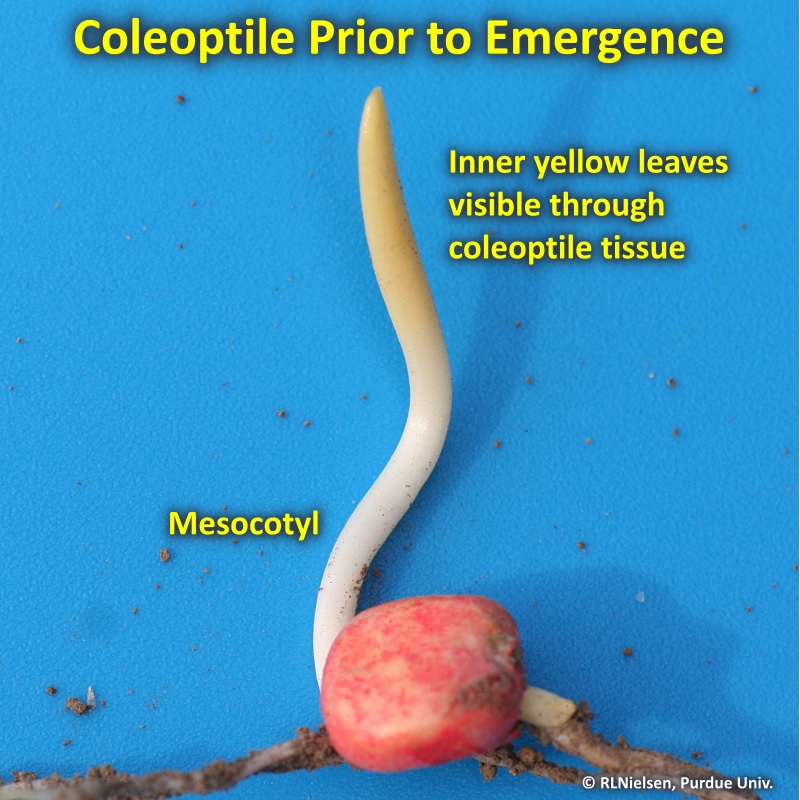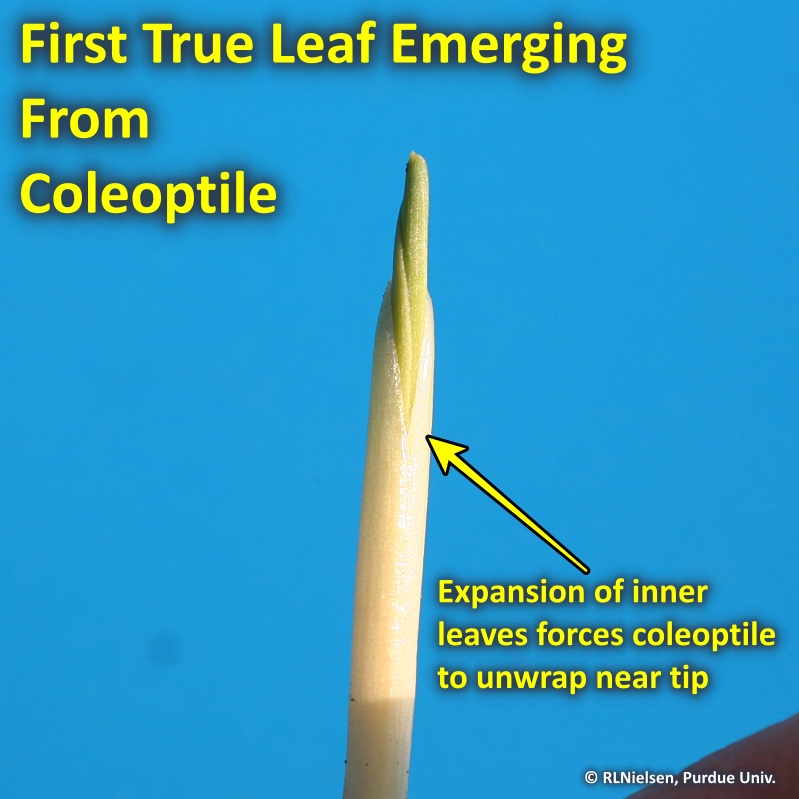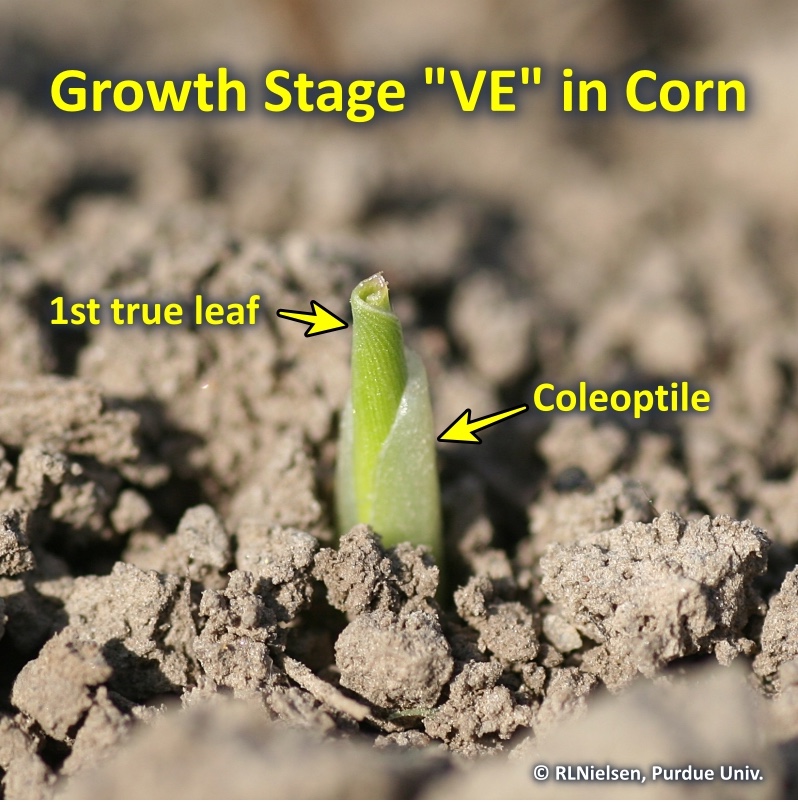Successful germination alone does not guarantee successful emergence of a corn crop. Elongation of the mesocotyl must elevate the coleoptile to the soil surface before the inner true leaves emerge from the protective tissue of the coleoptile. Growth stage VE refers to the emergence of the coleoptile and/or first leaves through the soil surface (Abendroth et al., 2011).
As with all of corn growth and development, germination and emergence are influenced by temperature, especially soil temperature. Corn typically requires from 100 to 120 Growing Degree Days (GDD, Fahrenheit) to emerge. Under warm soil conditions, the calendar time from planting to emergence can be as little as 4 days. Under cold soil conditions, emergence can take as long as four weeks.
Elongation of the mesocotyl elevates the coleoptile and its enclosed inner leaves towards the soil surface. The mesocotyl is the tubular, white, stemlike tissue connecting the seed and the base of the coleoptile. Technically, the mesocotyl is the first internode of the stem.
Useful Tip: Mesocotyls are thought to be physiologically capable of elongating successfully from at least a 6-inch planting depth. Realistically, corn can be planted at least three inches deep (if necessary to reach adequate moisture) and still emerge successfully.
As the coleoptile tip nears the soil surface, exposure to the red light component of solar radiation reduces the production of the growth-promoting hormone indoleacetic acid (IAA) from the coleoptile tip, which reduces the supply of IAA to the mesocotyl, and consequently elongation comes to a halt (Vanderhoef & Briggs, 1978; Barker-Bridges et al., 1998). Since the depth below the soil surface at which the coleoptile tip senses red light is fairly constant, the resulting depth of the crown (base) of the coleoptile is nearly the same (1/2 to 3/4 inch) for seeding depths of one inch or greater.
Useful Tip: When corn is seeded very shallow (less than about 1/2 inch), the crown of the coleoptile will naturally be closer to the soil surface, if not right at the surface. Subsequent development of the nodal root system can be restricted by exposure to high temperatures and dry surface soils.
The coleoptile tissue is wrapped somewhat like inner leaves are wrapped, or rolled, in the whorl. Expansion of the inner true leaves eventually forces the coleoptile to partially unwrap near the tip, allowing the first true leaf to emerge. If mesocotyl elongation has successfully elevated the coleoptile tip to the soil surface, emergence of the first true leaves will also occur successfully at or just above the soil surface.
Troubleshooting Considerations
Several factors can cause the coleoptile to split prematurely, allowing the leaves to emerge underground. Usually, more than one of the following factors are present when this problem occurs, making it difficult to place the blame on any one factor.
- Exposure to sunlight at deeper soil depths than usual due to cloddy seedbeds, dry seedbeds, sandy soils, or open seed furrows.
- Injury from certain herbicides, particularly under stressful environmental conditions. Symptoms include corkscrewed coleoptile, swollen mesocotyl and true leaves emerged from side of coleoptile.
- Surface crusting, cloddy seedbeds, rocky seedbeds, planter furrow compaction, or otherwise dense surface soil that physically restrict mesocotyl elongation and coleoptile penetration. The pressure of the expanding leaves within the coleoptile eventually ruptures the side of the coleoptile. Symptoms include corkscrewed coleoptile, swollen mesocotyl and true leaves emerged from side of coleoptile. Note the similarity to those symptoms from herbicide injury.
- Cold temperature injury, either from exposure to long periods of soil temperatures less than about 50F (10C) or from exposure to wide daily swings (25 to 30 degrees) in soil temperatures. Symptoms include absence of emerged coleoptile, corkscrewed mesocotyl or coleoptile and true leaves emerged from side of coleoptile. Note the similarity to those symptoms from herbicide injury.
Useful Tip: The mesocotyl should remain firm, white and healthy through at least the 6-leaf stage, if not longer. If it is mushy, discolored, or damaged prior to this stage, then it is likely part of the crop problem being investigated.
Related References
Abendroth, L.J., R.W Elmore, M.J. Boyer, and S.K. Marlay. 2011. Corn Growth and Development. Iowa State Univ. Extension Publication #PMR-1009. https://store.extension.iastate.edu/Product/Corn-Growth-and-Development [URL accessed Apr 2020].
Barker-Bridgers M., D.M. Ribnicky, J.D. Cohen, and A.M. Jones. 1998. Red-light-regulated growth: Changes in the abundance of indoleacetic acid in the maize (Zea mays L.) mesocotyl. Planta 204: 207-211
Nielsen, RL (Bob). 2015. Requirements for Uniform Germination and Emergence of Corn. Corny News Network, Purdue Univ. http://www.kingcorn.org/news/timeless/GermEmergReq.html. [URL accessed Apr 2020].
Nielsen, RL (Bob). 2017. Heat Unit Concepts Related to Corn Development. Corny News Network, Purdue Univ. http://www.kingcorn.org/news/timeless/HeatUnits.html. [URL accessed Apr 2020].
Nielsen, RL (Bob). 2019. Corkscrewed Corn Seedlings. Corny News Network, Purdue Univ. http://www.kingcorn.org/news/articles/timeless/Cornscrews.html. [URL accessed Apr 2020].
Nielsen, RL (Bob). 2019. Visual Indicators of Germination in Corn. Corny News Network, Purdue Univ. http://www.kingcorn.org/news/timeless/GerminationEvents.html. [URL accessed Apr 2020].
Vanderhoef, Larry N., and Winslow R. Briggs. 1978. Red Light-inhibited Mesocotyl Elongation in Maize Seedlings. I. The Auxin Hypothesis. Plant Physiology 61: 534-537.








